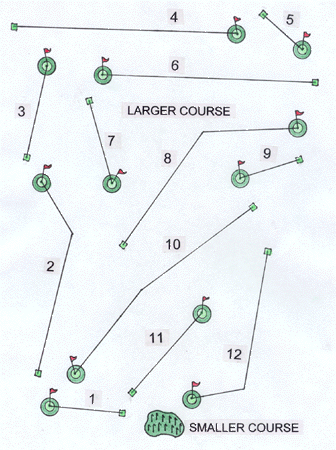
William W. Amick
ASGCA Golf Course Architect
|
|
|
|
|
|
|
ATTRACTING YOUTH AND
STARTING GOLFERS
|
Regular golf courses with a par of 72 take 150 acres or more, cost multi-millions of dollars to construct, require a majority of a million dollar annually to maintain, can seem discouragingly difficult to most trying to learn the game, are often crowded with experienced golfers impatiently pushing beginners playing ahead of them and demanding novices to concentrate for too long a period of time. Here is a friendly place for getting people hooked on golf by only taking a couple hours at the start, using three clubs and occupying approximately 20 acres. The three clubs are a putter, 7 iron and 5 hybrid/utility wood. These are the clubs selected by several leading golf instructors as giving beginners the most satisfying feedback. This facility consists of a larger and a smaller course. It needs a fraction of the construction and maintenance for a conventional golf course.
The holes of the smaller course have tee markers, a cup and practice putting green marker. Half the tees are located on a large green similar to a practice putting green and the other tees are on its fringe. The 7 iron is used from off the green with a par of 3 for each of those holes and the putter only from the tee markers on the green as 2 pars. The 12 holes have a total par 30. The green and fringe are artificial/synthetic turf, allowing this course to be constructed rapidly and playable in most weather. Maintenance is easy and unlike natural grass, the surface cannot be scuffed or damaged by “untrained” feet or over-enthusiastic swings. The large course is much smaller than a conventional golf course. It is composed of a mix of “one shot” and “two shot” holes, somewhat like regular par 3 and par 4 golf holes. The six par 3 holes and six par 4 holes have a total par of 42. From the tees of the one shot holes the 7 iron will generally be hit. The hybrid club is used from the tees of the longer holes and either club can be chosen for the second shot and beyond, if necessary. There is a cup, pin and flag for each hole, but the rest of the course is not so typical. The tees are synthetic turf to handle wear and potential damage from non-schooled golfers. The natural grass on most of the rest of this course is maintained at fairway-height for ease of play and to facilitate beginners quickly finding their ball no matter where it goes. This course does not have conventional greens. A “doughnut” of slightly shorter grass is mowed around each cup. This is for the scoring system, not putting. When a player’s ball stops in the shorter grass of the doughnut portion, the player picks up their ball and adds two strokes as their score for that hole. When their ball stops on the fairway-height grass immediately surrounding the cup inside the doughnut, they pick it up and add only one stroke. If with skill and maybe a little luck a ball hit from outside the doughnut goes in the hole, no additional stroke is added. All putting is done on the smaller course, so there is no waiting for other players to mark or putt, no lining up putts, no three or four putts and hence no time-consuming delays spent on greens of the main course. There could be hazards players must contend with following stray shots and thus adding more strategy to the holes, but nothing so difficult to overwhelm beginners. The smaller course is played with a golf ball. The larger with the limited-distance Cayman ball Jack Nicklaus had developed. It is much easier than a golf ball to get this ball pleasingly airborne, especially rewarding for erratic swingers. The Cayman ball is also essential to shrinking the length of the holes and even allowing them closer together. Because the ball doesn’t hook and slice as much and due to its lightness, errant shots are not hazardous to players on adjacent holes or to nearby property. As with any course, how suitable the site originally is, how well the course is designed and how adequately it is maintained will contribute to a course’s appeal. Combined par of the small course and the large one is 72. A primary goal of all this is to interest beginners. The setup of this low cost course and the procedures are aimed at bringing these players back for more, soon and often. In promoting their comfort, it should help encourage those who start with a strong feeling of insecurity from lack of experience and fear of being embarrassed. The whole activity gives them quick fun at low fees. Everyone is invited to give these courses a try, whether with family members, doing it with friends or alone. It is not intended to be a substitute for golf and many of the participants will move on to “big” golf. So programs to teach good swing techniques, all aspects of golf including course management, the Rules of Golf and etiquette could be conducted at a facility. Where practical, it would be great for regular courses to have a beginners course. This is for growing new golfers to increase the present field and eventually cultivating the next crop. To get more free information about any and all of these matters: a course more suitable to beginners; a club easiest for beginners to learn with; a ball friendlier to beginners; contact me now, Bill Amick at 1-386-767-1449, amick@iag.net or P. O. Box 1984, Daytona Beach, Florida 32115 USA. |
|
|
| Professional Golf Course Designer - Bill Amick |
| P.O.
Box 1984 Daytona Beach, FL 32115 Telephone (386) 767-1449 |
| amick@iag.net |
